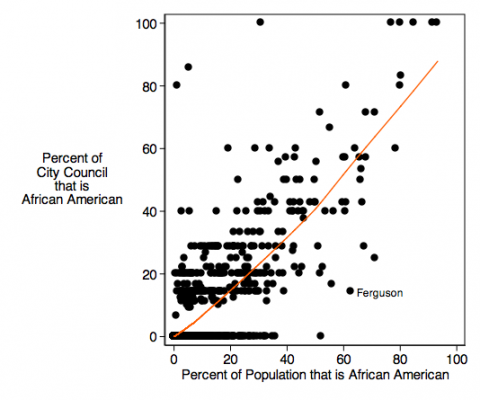Why are the residents of Ferguson, Missouri—a majority of whom are black—represented by a local government that is almost entirely white? This question has preoccupied a few scholars and journalists since last week. On Friday, Brian Schaffner, Wouter Van Erve, and Ray LaRaja wrote an interesting post at the Monkey Cage that looked at these disparities and suggested that it was largely due to two factors: 1) the timing of local elections (Ferguson’s city council elections are held in April of odd-numbered years), and 2) the non-partisan nature of local elections there. Both of these factors tend to depress turnout substantially, and seem to depress turnout disproportionately among African Americans. Over at Slate, Jordan Weissmann explained that the poverty and relative transience common among black communities in the inner-ring suburbs of the South makes them far less likely to turn out in local elections.
There are serious and deep systemic issues at play here that will require institutional solutions if they are to be addressed.
So this sounds like an important phenomenon but it’s one that is easily explained by some well understood features of the political environment. Given the institutional and demographic features of Ferguson, we would expect the percent of the city council that is black to be less than the percent among the population. But just how much?
To get a sense of where Ferguson stands, I examined a 2001 data set of U.S. cities. (The data set comes from the International City/County Management Association and was generously provided to me by Jessica Trounstine, who used it for a paper with Melody Valdini.) The chart below shows the relationship between the percent of the population that is black and the percent of the city council that is black as of 2001 in cities with at least 10,000 residents. The data point for Ferguson is labeled.

(Chart: Jessica Trounstine/ICMA)
As we can see, there is a very strong relationship between these two variables. The greater the African American population, the greater the percentage on the city council. Those don’t track each other perfectly though. A city with a 50 percent African American population would only be expected to have about 43 percent of its city council be black. Only at about 58 percent African American would we expect the population to have a majority black city council.
The other important lesson from this graph is that Ferguson is a serious outlier. As of 2001, it was a majority African American city with zero African Americans on the city council. The only city with a greater representational disparity was Riverdale, Georgia, but African American representation in that city has increased dramatically since then. Ferguson, meanwhile, has gained one African American city council member since then (17 percent of the council), but its African American population has increased to 67 percent, meaning it’s still a rather extreme outlier in terms of representation.
I set up a regression equation to see what sorts of institutional variables predicted the difference between the African American city council percentage and the African American population percentage, or the representational gap. There are quite a few factors that seem important, but none come close to explaining Ferguson. That gap is about four points greater in Southern states, and it’s modestly less in more urban and wealthier cities. Having off-cycle or partisan elections doesn’t seem to matter much here. None of these factors can explain Ferguson’s 53-point representational gap in 2001, or its 50 percent gap today.
This isn’t to dismiss Ferguson as a meaningless outlier. As Clarissa Hayward notes: “Ferguson is anything but anomalous. It’s an all-too-familiar manifestation of how racial injustice lives on, even after significant shifts in white racial attitudes.” There are problems with representation in a number of places across the country, and Ferguson is, sadly, hardly the only city to see an unarmed young black man gunned down by a white police officer. But trying to repair a place like Ferguson will obviously require more than hugs, peaceful marches, calls for unity, and civilian oversight of police. There are serious and deep systemic issues at play here that will require institutional solutions if they are to be addressed. There are national problems, but even given that, Ferguson’s illnesses appear to be unusually acute.
UPDATE — August 21, 2014: Trounstine was able to gather the data for 2011. Below is an updated chart. While Ferguson is no longer at the bottom of the graph, it is still one of the largest negative outliers in the data set.

(Chart: Jessica Trounstine/ICMA)




